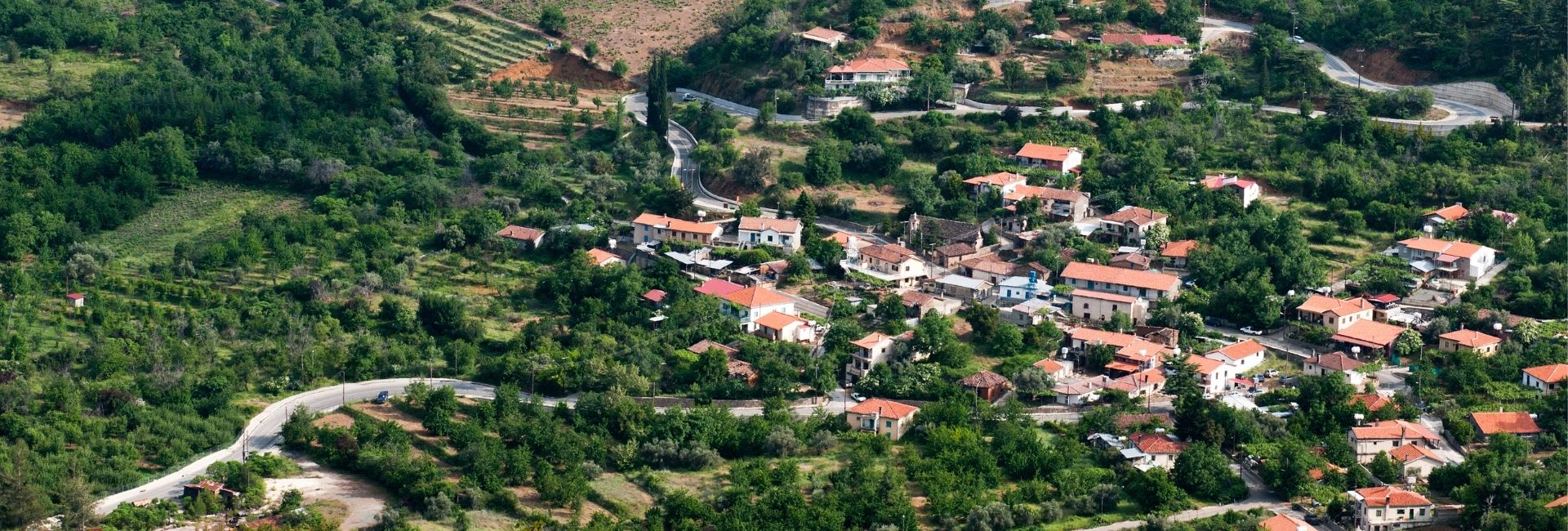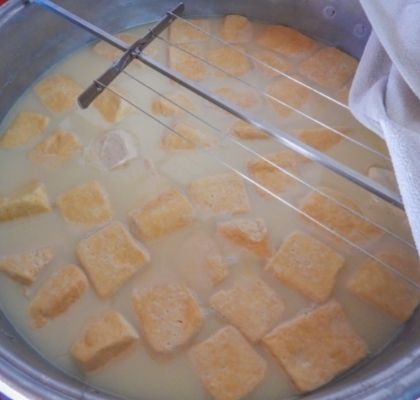
History of Halloumi
Halloumi, fresh or mature, has always been the flagship of Cyprus’ authentic cuisine. For more than 1,500 years, it has been a key compoment of the local diet and has been closely associated with the culture and traditions of its people.
Historical reports dating from 1554, during the Venetian Rule of the island confirm that Halloumi was produced in Cyprus at the time. Well-known writer, Florio Bustron notes in his writings that Cyprus produces, using sheep and goat milk, a cheese that was named "caloumi" in Venetian language, prepared in March, a period during which there is an abundance of best quality, full fat milk. Halloumi was also renowned overseas as described by writer and traveller Richard Pococke in 1738 "they make (halloumi) cheese from goat's milk, which is famous all over the Levant, and it is the only good cheese to be met in these parts; they are small and thick, much in the shape of ancient weights ... ". In those old times, halloumi in brine was an essential part of the people's diet, especially in the absence of any refrigeration facilities.
The role of “Halloumi” cheese in the life of the inhabitants of Cyprus from ancient times until today
Based on historical reports, the production of Halloumi cheese in Cyprus has been known for several centuries. In a codex containing five manuscripts on the history of Cyprus and kept in the library of the Correr Municipal Museum in Venice, the oldest written reference to Halloumi as “caloumi” is found. The manuscript contained in this report is a study of the well-known head of the Secretariat in the Venetian administration of Cyprus, Florios Voustroniou and dates from 1554. The manuscript was transcribed and transported to Venice by Leonardo Dona, later Dogis, son of the Venetian Governor of Cyprus Giovanni Batista Dona, who came to Cyprus when he was 20 years old with his father. The handwritten document belongs to the Library of the Municipal Museum Correr of Venice (Biblioteca Civico Museo Correr di Venezia) in the codex Codici ms Dona dale Rose, n 45, f 103r. Florio Bustron refers to the cheese called “halloumi” (‘calumi’ in Italian-Venetian). Elias of Pesaro, who visited Famagusta in 1563 AD, mentions in a letter that local cheese is made from a mixture of sheep’s, goat’s and cow’s milk, however it does not keep for long. Richard Pococke visited Cyprus in 1738 AD and mentions that Cypriots make cheese from goat’s milk. This cheese was very well known and was considered the only good cheese in the region. In 1788 AD, Archimandrite Kyprianos, in his book ‘Chronological History of the Island of Cyprus’, refers to «χαλλούμια, ήτοι γλώσσαι από τυρί νοστιμότατα» (“Halloumi, slices of delicious cheese”) which were produced from sheep’s and goat’s milk (Archimandrite Kyprianos, 1788). According to Bevan, the most famous cheese that was most often produced in Cyprus at the beginning of the 19th century was “Halloumi’’.
The importance of the presence of “Halloumi” cheese in the life of the inhabitants of Cyprus is also evident from references found about this cheese through art, according to the following examples. In 1836 AD, D. K. Byzantios wrote the play ‘Babylonia’ which takes place in Nafplio in 1827 AD, and states that one of the protagonists (who was playing a Cypriot) had asked to eat Halloumi, ‘the cheese they ate in Cyprus’. Moreover, a poem entitled ‘To Ptochon tis Kyprou’ (‘Το πτωχόν της Κύπρου’) by poet Giorgos Viziinos, who was in Cyprus in 1867 AD, describes eating Halloumi cheese at a village (‘Θυμούμαι πρώτα στο χωριό, επείνασα λιγάκι, χαλλούμι (‘’halloumi’’) και ψωμάκι, και ευθύς έγινα θεριό’).
Halloumi has long played an important role in the diet of Cypriots and would meet the needs of the Cypriot family all year round. According to P. Xioutas (2001), Halloumi, the ‘specially made renowned cheese of Cyprus’ was one of the most common snacks in every Cypriot household and was a staple for every agricultural family. In 1934, in his article on the dairy industry of Cyprus, A. Pitcairn states that Halloumi is a special product produced in all parts of Cyprus for the purposes of local consumption.
In the old days, the preparation of “Halloumi” cheese in the farmhouses was of particular importance for the residents since, in addition to meeting their nutritional needs, it was a practice of solidarity and mutual assistance between families, as well as an opportunity to socialize (especially among the women who prepared the cheese most of the time). More specifically, due to the small quantities of milk that each family produced from its own animals, all the neighbours gave their milk to one person so that the necessary amount of milk would be collected to make Halloumi. In other words, the neighbours collaborated (“cooperative”) to collect the milk and make Halloumi, one neighbour at a time, in rotation. In this way, within 1-2 months, the whole neighbourhood had Halloumi ready for consumption. The way in which the “cooperative” operated is also described by Economides (2004), according to whom, it consisted of 10-15 women of the village, depending on the number of goats that each woman had. The woman who had the most goats was the leader of the cooperative and she was the first to start the curdling of the milk and the production of Halloumi. The woman who would curdle the milk was referred to as the ‘Galatarka’ (“γαλαταρκά”).
Along with the production of Halloumi at home, small cheese dairies were gradually created, where Halloumi was produced either for the neighbourhood or for exporting. It is noteworthy that later, in the early 1940s, official Halloumi production licences were issued by the competent authorities (as shown in copies of licenses for the period 1939-1955). Halloumi was the cornerstone of the island’s cheese production.
The relationship of Halloumi with the inhabitants of Cyprus is also shown by the fact that several families, according to the lists of the Cyprus Telecommunication Authority, have the surname ‘Halloumas’, ‘Hallouma’, ‘Halloumakis’, ‘Halloumis’. In addition, in the Pyrga village of the district of Famagusta, there is an area called Halloumaes (‘Χαλλουμάες’). The abovementioned surnames, as well as the name of the area, are directly connected with the production of Halloumi in the past.
Halloumi also held an important place in agricultural fairs held in Cyprus. One such example is the ‘Agricultural and Animal Show’ held in Paphos in November 1915, where there were 168 entries in category D ‘Miscellaneous’, the most important of which were Halloumi and carobs. At the Lysi Agricultural Show in September 1939, Halloumi’s participation at the agricultural exhibition, which was published in both Greek and Turkish, there is reference to the products that can participate in the competition. The word for “Halloumi” in Turkish is “Hellim”. The Turkish Cypriot producers of Halloumi either use both names of our traditional product or only the name “Hellim”. There is ample evidence that both “Halloumi” and “Hellim” define the same traditional product of Cyprus.
Along with local consumption, Halloumi has long been exported to various countries around the world, thus financially contributing to the survival of the island’s inhabitants. According to Archimandrite Kyprianos, “the country gives a large quantity of the cheeses abroad” («από τα τυριά δίδει ο τόπος έξω μεγάλην ποσότηταν»). According to V. White (1863), Halloumi was often exported to Syria. The Director of the Department of Agriculture of Cyprus, M.T. Dawe, states in 1928 that Halloumi was exported to Egypt, Syria, Greece, Turkey, Palestine, France, Sudan, Dodecanese, United Kingdom, America, West and East Africa, Australia and China. Halloumi exports gradually began to be administered by the competent state authorities (evident from copies of producers’ export requests to various countries, e.g. Lebanon, Egypt, Mersin during the period 1916-1921, as well as from the replies to these requests from the competent authorities).
Exports still very much continue in various countries, including to countries with Cypriot communities since Cypriot immigrants maintain their dietary habits. According to data from the Statistical Service during the period 1993-2010, there was an increase in total exports of Halloumi from about 1,660 tonnes in 1993 to about 7,688 tonnes in 2010. It should be noted that in 2010, 75% of total exports of Halloumi were destined to Europe, of which about 43% to the United Kingdom, a country with a strong Cypriot presence due to the Cypriot communities, resulting in high demand / consumption of this product.
Today halloumi is exported to more than 50 countries, with the main export markets being the UK, Sweden, Germany, Australia, Austria, Denmark and Poland. These seven markets account for 81% of total halloumi exports internationally. It is worth mentioning that from 2016 to 2021, halloumi exports increased by more than 30%.
Halloumi cheese is Cyprus’ crown jewel of the agricultural exports products, with the value and quantities of Halloumi shipped around the world growing every year. Halloumi exports currently total at almost 40 million kilos worth more than €250 million a year and is exported to over 50 countries. With the popularity of halloumi rising and more markets steadily being opened, producers predict that exports could reach over €300 million in 2023.
Excerpt from the book «THE DAIRY CULTURE OF CYPRUS: HISTORY – TRADITION – FOLKLORE»
Production process
Although halloumi was sometimes produced by shepherds, in the traditional society of Cyprus the production of halloumi was mainly women’s work, and was an art that was passed down from stete (grandmother) to mother and from mother to daughter. Indeed, it was considered a significant qualification for a future bride to know how to κάμνει το γάλαν (literally, to work the milk), and even today, women who make good halloumi at home are known by their own names. Undoubtedly, the production of halloumi was a demanding process, and it is no accident that women helped each other to prepare it. This involved a kind of practical social solidarity, not unlike that involved in the collective planting of the new vines.
Source: Lazarou, C, et al. (2021). "Main body of application filed for registration of Cypriot dairy products on the National UNESCO Intangible Heritage List." In Pavlou M., Suhair Majaj L. (eds), The Dairy Culture of Cyprus: History-Tradition- Folklore, Cyprus Food and Nutrition Museum: Nicosia.
For more information, you may visit the website of Cyprus Food Museum foodmuseum.cs.ucy.ac.cy







